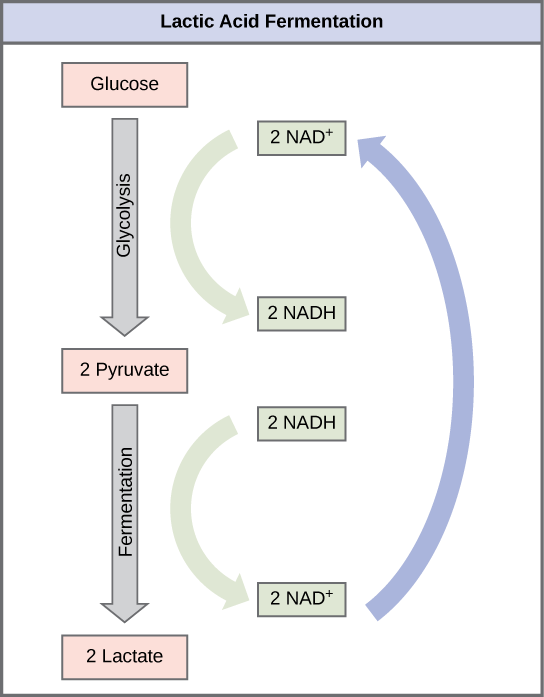| << Chapter < Page | Chapter >> Page > |
In glycolysis, NAD + is converted to NADH; what happens to the NADH produced?
Be prepared to discuss this in class.
During glycolysis NAD + is reduced to NADH and glucose is oxidized to pyruvate. During this process the cells must regenerate NAD + by a second redox reaction. In respiration, this occurs when NADH is used as an electron donor to the electron transport chain. If cells lack an electron transport chain, i.e. can not respire, then cells must use other means to regenerate NAD + . This is where fermentation comes into play.
In aerobic respiration, the final electron acceptor is an oxygen molecule, O 2 . If aerobic respiration occurs, then ATP will be produced using the energy of the high-energy electrons carried by NADH or FADH 2 to the electron transport chain. If aerobic respiration does not occur, NADH must be reoxidized to NAD + for reuse as an electron carrier for glycolysis to continue. How is this done? Some living systems use an organic molecule as the final electron acceptor. Processes that use an organic molecule to regenerate NAD + from NADH are collectively referred to as fermentation .
The fermentation method used by animals and some bacteria like those in yogurt is lactic acid fermentation ( [link] ). This occurs routinely in mammalian red blood cells and in skeletal muscle that has insufficient oxygen supply to allow aerobic respiration to continue (that is, in muscles used to the point of fatigue). In muscles, lactic acid produced by fermentation must be removed by the blood circulation and brought to the liver for further metabolism. The chemical reaction of lactic acid fermentation is the following:
The enzyme that catalyzes this reaction is lactate dehydrogenase. The reaction can proceed in either direction, but the left-to-right reaction is inhibited by acidic conditions. This lactic acid build-up causes muscle stiffness and fatigue. Once the lactic acid has been removed from the muscle and is circulated to the liver, it can be converted back to pyruvic acid and further catabolized for energy.

What reactants are used up in glycolysis (need to be replaced)?
h
Which reactants that are used up in glycolysis are "replaced" by the act of fermenting?
a
Tremetol, a metabolic poison found in white snake root plant, prevents the metabolism of lactate. When cows eat this plant, Tremetol is concentrated in the milk. Humans who consume the milk become ill. Symptoms of this disease, which include vomiting, abdominal pain, and tremors, become worse after exercise. Why do you think this is the case?

Notification Switch
Would you like to follow the 'Ucd bis2a intro to biology v1.2' conversation and receive update notifications?